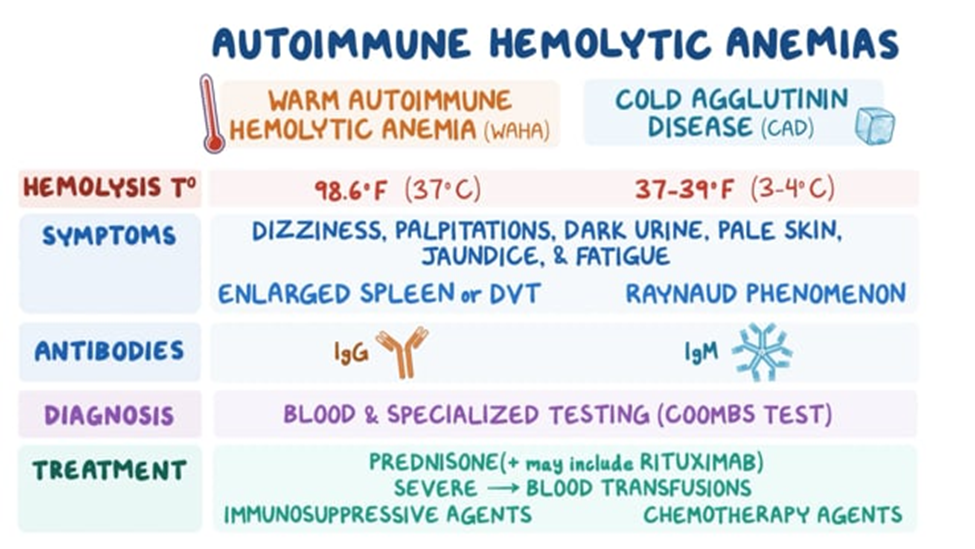A client comes into the clinic complaining of fatigue. Blood work shows an increased bilirubin concentration and an increased reticulocyte count. What would the nurse suspect the patient has?
Leukemia
Hemolytic anemia
Hypoproliferative anemia
Thrombocytopenia
The Correct Answer is B
A. Leukemia:
Explanation: Leukemia is a cancer of the blood-forming tissues, including the bone marrow and lymphatic system. It typically presents with an abnormal increase in white blood cells. While fatigue can be a symptom, increased bilirubin concentration and an increased reticulocyte count are not typical findings in leukemia.
B. Hemolytic Anemia:
Explanation: Hemolytic anemia is characterized by the premature destruction of red blood cells, leading to an increased release of bilirubin (from the breakdown of hemoglobin) and an increased reticulocyte count (as the body attempts to compensate by producing more red blood cells). This is a likely possibility given the presented symptoms.
C. Hypoproliferative Anemia:
Explanation: Hypoproliferative anemia is characterized by a decreased production of red blood cells. It is unlikely in this scenario, as an increased reticulocyte count suggests an attempt by the bone marrow to increase red blood cell production.
D. Thrombocytopenia:
Explanation: Thrombocytopenia is a condition characterized by a low platelet count. It does not typically present with an increased bilirubin concentration or an increased reticulocyte count.

Nursing Test Bank
Naxlex Comprehensive Predictor Exams
Related Questions
Correct Answer is B
Explanation
A. Increase the intake of vitamin E to enhance absorption:
While vitamin C can enhance iron absorption, vitamin E does not play a significant role in iron absorption. Vitamin C-rich foods can be advised to enhance iron absorption.
B. Iron will cause the stools to darken in color:
This statement is accurate. Iron supplements can cause stools to appear darker in color, often black or greenish-black. This change in stool color is normal and expected when taking iron supplements.
C. Take the iron with dairy products to enhance absorption:
Dairy products can inhibit iron absorption. It's better to take iron supplements with vitamin C-rich foods or orange juice to enhance absorption.
D. Limit foods high in fiber due to the risk for diarrhea:
Fiber-rich foods do not necessarily need to be limited when taking iron supplements. However, some individuals may experience constipation when taking iron supplements, in which case increasing fluid intake and dietary fiber can help alleviate constipation.
Correct Answer is C
Explanation
A. "I will make sure I call the diabetes educator each time I adjust my insulin dose."
This statement suggests a reliance on insulin adjustment and implies frequent contact with the diabetes educator. However, it doesn't address the primary treatment for type 2 diabetes.
B. "I read that a pancreas transplant will provide a cure for my diabetes."
This statement mentions a pancreas transplant, which is a significant and rare intervention typically reserved for severe cases of diabetes. However, it's not considered the primary treatment for type 2 diabetes.
C. "I will make sure to follow the weight loss plan designed by the dietitian."
This statement aligns with a key aspect of managing type 2 diabetes, as weight management, along with diet and exercise, is a primary approach. Lifestyle modifications, including weight loss, are often part of the primary treatment plan.
D. "I will take my oral anti-diabetic agents when my morning blood sugar is high."
This statement indicates an understanding of the importance of oral anti-diabetic agents, which are commonly used in the management of type 2 diabetes. Timing medication based on blood sugar levels is a key aspect of treatment.
Whether you are a student looking to ace your exams or a practicing nurse seeking to enhance your expertise , our nursing education contents will empower you with the confidence and competence to make a difference in the lives of patients and become a respected leader in the healthcare field.
Visit Naxlex, invest in your future and unlock endless possibilities with our unparalleled nursing education contents today
Report Wrong Answer on the Current Question
Do you disagree with the answer? If yes, what is your expected answer? Explain.
Kindly be descriptive with the issue you are facing.
